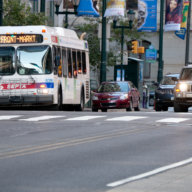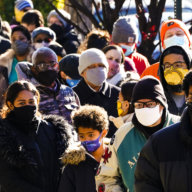Full water service has been restored to residents of Old City and beyond after a 36-inch main break caused a geyser to shoot out of the asphalt near 3rd and Walnut streets yesterday afternoon, flooding the popular tourism district with an estimated five to six million gallons of water.



The massive flooding also buckled the asphalt, closing
Walnut Street between 2nd and 4th streets and 3rd Street between
Chestnut and Locust streets to both pedestrian and vehicular traffic, prompting frustration from commuters and tourists.


The streets will be
closed until further notice. “I can only tell you that the street will be closed
indefinitely,” Philadelphia Water Department spokesman John DiGuilio said today, noting that a definitive timetable
for repairs has not yet been set. “This is going to be a very quiet
intersection for the time being.”

Other utility companies also have lines running at various depths through the intersection, including PECO Energy Company, Philadelphia Gas Works and Verizon, DiGuilio said. “Moving forward, it is largely going to be excavation,” he said. Crews are now working to expose the other utility lines so that they can be assessed for damage by their respective crews and the Water Department can move forward with its repairs to the main.


 Workers were called to the intersection around 12:30 p.m. yesterday for a
Workers were called to the intersection around 12:30 p.m. yesterday for a
report of a leak. “The leak was pinpointed to be at a joint on a
36-inch transmission main,” DiGiulio
said in a statement yesterday. “As the workers were uncovering the joint
to begin a repair, the main ruptured. Crews immediately began the
process of shutting down the main.” He said that the timing was pure
coincidence and that the initial repair crew did not do anything to
prompt the rupture.

Residents as far away as Northern Liberties, South Philadelphia and
Center City West reported low water pressure yesterday, some so low it
couldn’t be used at all. Some area businesses were forced to shut their
doors for several hours as the problem was resolved. The flooding was
brought under control by about 2 p.m. yesterday and full water service
was restored. The rupture caused traffic, transit and water service disruptions and
led to the evacuations of three families, who have since
returned home.


Large main breaks such as these have become a more common occurrence, at least when it comes to the headlines – the city is still working to fully restore the area in Point Breeze surrounding 21st and Bainbridge streets, where a 48-inch water main rupture opened a sinkhole in late July. An eight-inch main broke about a week after that at Willits and Ashton roads in Northeast Philadelphia, followed three days later by another burst that led to flooding at Front and Tioga streets in Kensington.

When discussing the seemingly-frequent breakdowns over the summer, Water Commissioner Howard Neukrug told Metro that, in general, two factors that combine to stress on Philadelphia’s water infrastructure are its age and the lack of funding it receives, both from the federal government and from utility payers, who in this city enjoy comparatively low water rates.

The exact cause of the Bainbridge Street break, at the least, will likely never amount to more than speculation. A failure investigation summary released in early August by engineering firm CorTrol Services found no evidence of pipe corrosion, but could not pinpoint a direct cause. “It is believed that the fracture initiated as a result of atypical bending stresses at the point of fracture,” it concluded. “These stresses could have resulted from a combination of traffic and soil loading. Any evidence to conclusively determine the exact cause of the loading was washed away when the main ruptured.”




























